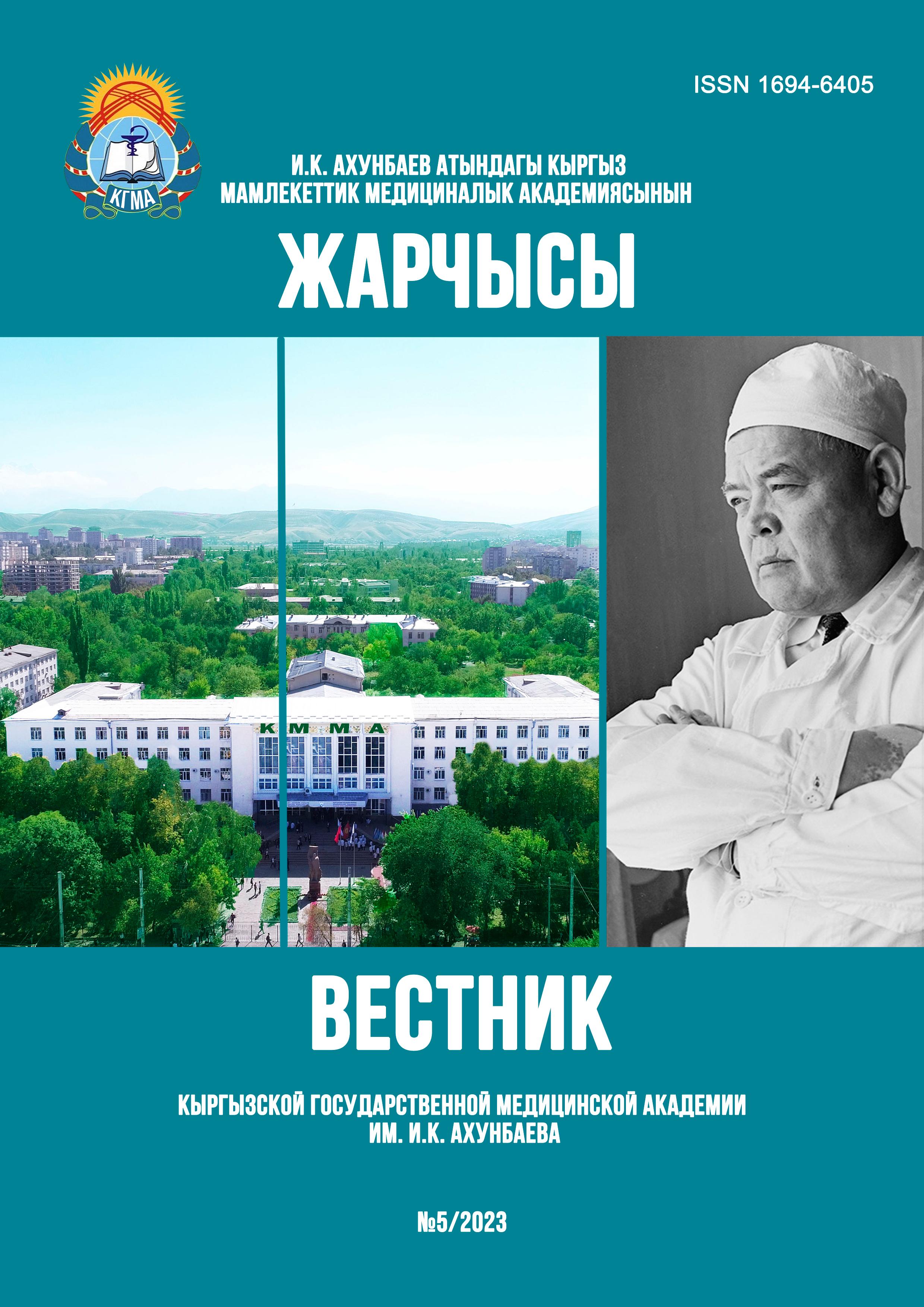ENDOTHELIN-1 AS A PROGNOSTIC MARKER FOR THE DEVELOPMENT OF SOCIALLY SIGNIFICANT DISEASES IN PEDIATRICS (LITERATURE REVIEW)
DOI:
https://doi.org/10.54890/1694-6405_2023_5_121Abstract
The search for specific prognostic and diagnostic markers is an urgent task in modern pediatrics. The endothelium is an active system that functions as a receptor-effectors organ that responds to an exogenous or endogenous stimulus with the release of various molecules designed to restore vascular-tissue homeostasis. The endothelium, on the one hand, is involved in almost all processes defined as homeostasis, homeostasis and inflammation, on the other hand, it is the first link in the pathogenesis of various diseases in both adults, children and adolescents. To date, the idea of endothelial dysfunction as a condition characterized by an imbalance of mediators that normally ensure the optimal course of endothelium-dependent processes has been formed. Due to the proven role of the development of endothelial dysfunction in the pathogenesis of diseases of the cardiovascular, respiratory systems, metabolic disorders, etc. Endothelin-1 (ET-1) can be used as such a prognostic and diagnostic marker of endothelial dysfunction. Purpose of the study: analysis and synthesis of literature data using WoS, Scopus, RSCI databases. Based on clinical and experimental data, it can be concluded that the use of markers of endothelial dysfunction, including the level of endothelin-1 in blood serum, can be used to assess the severity of socially significant diseases when they manifest in childhood and adolescence.
Keywords:
endothelium, endothelial dysfunction, endothelin-1, prognostic marker, socially significant diseases, children, adolescents.References
1. Gottlieb SS, Harris K, Todd J, Estis J, Christenson RH, Torres V, et al. Prognostic significance of active and modified forms of endothelin 1 in patients with heart failure with reduced ejection fraction. Clin Biochem. 2015;48(4-5):292-6. https://doi.org/10.1016/j.clinbiochem.2014.12.012
2. Yanagisawa M, Masaki T. Molecular biology and biochemistry of the endothelins. Trends Pharmacol Sci. 1989;10(9):374-8. https://doi.org/10.1016/0165-6147(89)90011-4
3. Masaki T. Endothelin in vascular biology. Ann N Y Acad Sci. 1994;714:101-8. https://doi.org/10.1111/j.1749-6632.1994.tb12034.x
4. Kawanabe Y, Nauli SM. Endothelin. Cell Mol Life Sci. 2011;68(2):195-203. https://doi.org/10.1007/s00018-010-0518-0
5. Davenport AP, Hyndman KA, Dhaun N, Southan C, Kohan DE, Pollock JS, et al. Endothelin. Pharmacol Rev. 2016;68(2):357-418.https://doi.org/10.1124/pr.115.011833
6. Sugiura M, Snajdar RM, Schwartzberg M, Badr KF, Inagami T. Identification of two types of specific endothelin receptors in rat mesangial cell. Biochem Biophys Res Commun. 1989;162(3):1396-401. https://doi.org/10.1016/0006-291x(89)90829-2
7. Speck D, Kleinau G, Szczepek M, Kwiatkowski D, Catar R, Philippe A, Scheerer P. Angiotensin and Endothelin Receptor Structures with Implications for Signaling Regulation and Pharmacological Targeting. Front Endocrinol (Lausanne). 2022;13:880002. https://doi.org/10.3389/fendo.2022.880002
8. Sano FK, Akasaka H, Shihoya W, Nureki O. Cryo-EM structure of the endothelin-1-ETB-Gi complex. Elife. 2023;12:e85821. https://doi.org/10.7554/eLife.85821
9. Shihoya W, Nishizawa T, Okuta A, Tani K, Dohmae N, Fujiyoshi Y, et al. Activation mechanism of endothelin ETB receptor by endothelin-1. Nature. 2016;537(7620):363-368. https://doi.org/10.1038/nature19319
10. Elisa T, Antonio P, Giuseppe P, Alessandro B, Giuseppe A, Federico C, et al Endothelin Receptors Expressed by Immune Cells Are Involved in Modulation of Inflammation and in Fibrosis: Relevance to the Pathogenesis of Systemic Sclerosis. J Immunol Res. 2015;2015:147616. https://doi.org/10.1155/2015/147616
11. Patel JM. Multisystem Inflammatory Syndrome in Children (MIS-C). Curr Allergy Asthma Rep. 2022;22(5):53-60. https://doi.org/10.1007/s11882-022-01031-4
12. Cohen M, Yaseen H, Khamaisi M, Gendelman R, Zuckerman-Levin N, Shilo S, et al. Endothelin-1 levels are decreased in pediatric Type 1 diabetes and negatively correlate with the carotid intima media thickness. Pediatr Diabetes. 2021;22(6):916-923. https://doi.org/10.1111/pedi.13237
13. Cazzaniga E, Bonino B, Palestini P, Parati G, Genovesi S. Endothelin-1/nitric oxide balance and HOMA index in children with excess weight and hypertension: a pathophysiological model of hypertension. Hypertens Res. 2019 Aug;42(8):1192-1199. https://doi.org/10.1038/s41440-019-0253-3
14. Genovesi S, Giussani M, Orlando A, Lieti G, Viazzi F, Parati G. Relationship between endothelin and nitric oxide pathways in the onset and maintenance of hypertension in children and adolescents. Pediatr Nephrol. 2022;37(3):537-545. https://doi.org/10.1007/s00467-021-05144-2
15. Song P, Zhang Y, Yu J, Zha M, Zhu Y, Rahimi K, Rudan I. Global Prevalence of Hypertension in Children: A Systematic Review and Meta-analysis. JAMA Pediatr. 2019;173(12):1154-1163. https://doi.org/10.1001/jamapediatrics.2019.3310
16. Brady TM, Redwine KM, Flynn JT; American Society of Pediatric Nephrology. Screening blood pressure measurement in children: are we saving lives? Pediatr Nephrol. 2014;29(6):947-50. https://doi.org/10.1007/s00467-013-2715-1
17. Genovesi S, Antolini L, Giussani M, Brambilla P, Barbieri V, Galbiati S, et al. Hypertension, prehypertension, and transient elevated blood pressure in children: association with weight excess and waist circumference. Am J Hypertens. 2010;23(7):756-61. https://doi.org/10.1038/ajh.2010.50
18. Wang Y, Chen S, Du J. Bosentan for Treatment of Pediatric Idiopathic Pulmonary Arterial Hypertension: State-of-the-Art. Front Pediatr. 2019;7:302. https://doi.org/10.3389/fped.2019.00302
19. Haryono A, Ramadhiani R, Ryanto GRT, Emoto N. Endothelin and the Cardiovascular System: The Long Journey and Where We Are Going. Biology (Basel). 2022;11(5):759. https://doi.org/10.3390/biology11050759







